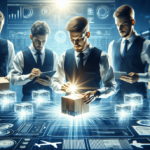How to Manage White Glove Fulfillment at Scale
In today's competitive marketplace, customer satisfaction is paramount. As customer expectations continue to rise, businesses must go above and beyond to meet these demands. This is where white glove fulfillment becomes crucial. White glove fulfillment emphasizes delivering a premium customer experience, from the moment an order is placed to its final delivery. But how can businesses effectively manage white glove fulfillment on a large scale? This article delves into comprehensive strategies and insights to address this challenge.
Understanding White Glove Fulfillment and Its Importance
White glove fulfillment goes beyond the standard "drop and go" delivery method. It involves a personalized approach where items are delivered directly inside the customer's home, unpacked, assembled, and even installed if necessary. According to a 2023 Statista report, businesses offering white glove services see a 20% increase in customer retention rates compared to those that do not.
Implementing white glove fulfillment is essential for several reasons:
- Enhanced Customer Experience: Provides convenience and a premium service that differentiates a business from its competitors.
- Reduced Returns and Damages: Careful handling during delivery minimizes the risk of product damage and theft, leading to fewer returns.
- Increased Loyalty: Exceptional service fosters customer loyalty and encourages repeat business.
- Higher Profit Margins: Premium services can justify higher pricing, contributing to better profit margins.
By offering white glove fulfillment, businesses not only elevate their service standards but also build a strong, loyal customer base.
The Challenges of Scaling White Glove Fulfillment
Scaling white glove fulfillment presents several challenges, including:
- High Coordination Demands: Managing detailed delivery processes requires meticulous planning and execution.
- Skilled Labor Requirement: Qualified personnel are needed to handle the specialized tasks involved in white glove services.
- Consistency Across Locations: Ensuring a uniform experience for customers regardless of their location requires robust training and quality control measures.
- Efficient Logistics: Streamlining logistics to handle increased volume without compromising service quality is vital.
- Scalable Technology: Implementing technology that can grow with the business is essential for maintaining efficiency.
Addressing these challenges is critical for businesses aiming to scale their white glove fulfillment operations effectively.
Strategies for Managing White Glove Fulfillment at Scale
To successfully manage white glove fulfillment on a larger scale, businesses can adopt the following strategies:
1. Adopt a Modular Approach
Combining in-house operations with third-party services allows businesses to scale flexibly while maintaining quality control. This hybrid model enables companies to manage peak times efficiently without overextending resources.
2. Leverage Advanced Technology
Utilize advanced technologies such as route planning software to optimize delivery routes, reduce travel time, and enhance overall efficiency. Additionally, inventory and order management systems like ShipBob can streamline operations and minimize errors.
3. Utilize Data Analytics
Implement data analytics to monitor customer feedback and operational metrics. This allows businesses to identify areas for improvement and make data-driven decisions to refine their fulfillment processes. Tools like Tableau can provide valuable insights into customer behavior and operational performance.
4. Invest in Employee Training and Development
Invest in comprehensive training programs to ensure that employees possess the necessary skills and knowledge for high-quality service delivery. Ongoing training helps maintain service standards and adapts to evolving customer needs.
5. Outsource Specialized Services
Consider partnering with specialized providers for tasks such as assembly or installation. Outsourcing these services can reduce costs, improve efficiency, and maintain the high level of service expected in white glove fulfillment.
The Role of Technology in Scaling White Glove Fulfillment
Technology is a cornerstone in scaling white glove fulfillment operations. Key technological tools include:
- Inventory Management Software: Tracks stock levels, monitors demand, and optimizes purchasing processes.
- Order Management Systems: Streamlines order processing, ensuring timely and accurate deliveries.
- Delivery Management Software: Optimizes delivery routes, reduces travel time, and enhances logistical efficiency.
- Customer Relationship Management (CRM) Systems: Manages customer interactions and improves service personalization.
Moreover, technologies like chatbots provide real-time customer support, enhancing communication and allowing businesses to offer a more personalized service. Advanced tracking and monitoring tools offer greater supply chain visibility, enabling proactive measures to address potential bottlenecks and improve overall efficiency.
Best Practices for Hiring and Training White Glove Fulfillment Teams
Building an effective white glove fulfillment team is crucial for maintaining service excellence. Best practices include:
- Recruiting Skilled Staff: Hire individuals with relevant experience and a strong focus on customer service.
- Comprehensive Training Programs: Cover all aspects of white glove fulfillment, including product knowledge, customer interaction, and delivery protocols.
- Ongoing Support and Feedback: Provide continuous training and regular feedback to ensure high performance and address any areas needing improvement.
- Robust Quality Control: Implement systems to monitor service standards and identify opportunities for enhancement.
- Employee Incentives: Offer incentives to motivate staff and encourage a culture of excellence.
Prioritizing customer satisfaction through well-trained teams ensures that business standards are consistently met and exceeded.
Optimizing Your Supply Chain for White Glove Fulfillment at Scale
Optimizing the supply chain is fundamental for scaling white glove fulfillment. Key considerations include:
- Reliable Supplier Network: Ensure that suppliers can deliver items on time and meet quality standards.
- Efficient Inventory Management: Utilize an inventory management system to track stock levels, monitor demand, and optimize purchasing processes.
- Effective Delivery System: Incorporate advanced route planning, reliable transportation, and professional installation services.
- Sustainable Practices: Implement eco-friendly practices to reduce environmental impact and appeal to environmentally conscious consumers.
Additionally, implementing technology solutions like data analytics can help identify demand trends and automate processes such as order fulfillment and tracking, leading to streamlined operations and improved efficiency.
Measuring Success in White Glove Fulfillment: Key Metrics to Track
To assess the effectiveness of white glove fulfillment, track the following key metrics:
- Customer Satisfaction Levels: Measure through surveys and feedback to gauge overall satisfaction.
- Net Promoter Score (NPS): Indicates the likelihood of customers recommending your service to others.
- Order Fulfillment Rates: Track the percentage of orders accurately processed and delivered on time.
- Delivery Times: Monitor the average time taken from order placement to delivery.
- Error Rates: Assess the frequency of mistakes in order processing and delivery.
- Return and Exchange Rates: Analyze the volume of returns or exchanges to evaluate product quality and fulfillment accuracy.
- Cost per Order: Calculate the total cost involved in fulfilling an order to manage profitability.
Monitoring these metrics enables businesses to identify areas for improvement, optimize processes, and ensure a superior customer experience.
Case Studies: Successful Examples of Scaling White Glove Fulfillment
Several businesses have successfully scaled their white glove fulfillment operations:
Amazon Prime Now
Amazon's Prime Now service offers a tailored one-hour delivery option for select items, enhancing customer convenience and satisfaction. By leveraging advanced logistics and a vast network of fulfillment centers, Amazon ensures swift and reliable deliveries.
Wayfair
Wayfair employs a modular approach, integrating both in-house and third-party services to scale operations while maintaining high service standards. Their robust logistics network and emphasis on customer service have made them a leader in the furniture and home goods market.
Net-a-Porter
Luxury fashion retailer Net-a-Porter provides personalized services such as same-day delivery, gift wrapping, and personal shopping, differentiating itself through exceptional white glove fulfillment. Their focus on high-quality service has built a loyal customer base and strong brand reputation.
These examples demonstrate the effectiveness of strategic planning and investment in white glove services to achieve scalability and maintain service excellence.
Overcoming Common Mistakes in Scaling White Glove Fulfillment
Scaling white glove fulfillment can be fraught with pitfalls. Common mistakes include:
- Underestimating Costs: Failing to account for the expenses involved in high-quality service delivery.
- Neglecting Scalable Technology: Not investing in technology that can support increased volume and complexity.
- Ignoring Operational Metrics: Overlooking key performance indicators that are essential for process optimization.
- Poor Communication: Lack of effective communication between teams can lead to errors and inefficiencies.
- Inadequate Training: Not providing sufficient training can result in inconsistent service quality.
To avoid these mistakes, businesses should:
- Invest in Comprehensive Training: Ensure teams are well-equipped to handle increased volume without compromising quality.
- Maintain Quality Control: Implement robust quality assurance processes to maintain high service standards as operations scale.
- Monitor and Adapt: Regularly review operational metrics and make necessary adjustments to improve efficiency and effectiveness.
- Enhance Communication Channels: Foster clear and consistent communication across all departments to ensure smooth operations.
- Plan Financially: Accurately estimate costs and budget accordingly to support scaling efforts.
By addressing these areas proactively, businesses can build a scalable and sustainable white glove fulfillment operation.
The Future of White Glove Fulfillment: Trends and Predictions
The white glove fulfillment industry is poised for significant evolution. Key trends shaping its future include:
- Automation and Robotics: Increased use of automated systems and robotics to enhance efficiency and reduce errors.
- Customized Delivery Options: Expansion of personalized delivery services to meet diverse customer needs.
- Sustainable Delivery Solutions: Adoption of eco-friendly transportation methods, such as electric vehicles, to reduce environmental impact.
- Augmented Reality (AR) and Virtual Reality (VR): Integration of AR and VR technologies to provide immersive customer experiences, such as virtual product demonstrations and interactive installations.
- Artificial Intelligence (AI) and Machine Learning: Utilizing AI to predict demand, optimize routes, and personalize customer interactions.
- Internet of Things (IoT): Implementing IoT devices for real-time tracking and monitoring of deliveries, ensuring higher transparency and accountability.
Staying abreast of these trends and integrating innovative solutions will be crucial for businesses aiming to lead in the white glove fulfillment space.
Conclusion: Sustaining White Glove Fulfillment at Scale
Managing white glove fulfillment at scale demands significant investment in time, resources, and strategic planning. By adopting a modular approach, leveraging advanced technologies, investing in thorough training and quality control, and diligently tracking key performance metrics, businesses can build a scalable and sustainable fulfillment operation. The cornerstone of success lies in maintaining a relentless focus on customer satisfaction, staying adaptable to industry changes, and committing to continuous improvement. Implementing these strategies will ensure that businesses deliver exceptional customer experiences consistently, fostering loyalty and driving long-term success.






















